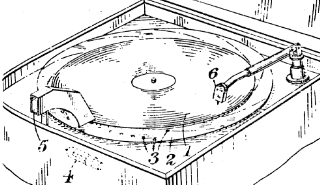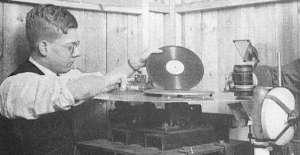Phonovision in print
 For Baird, the story of his recording process starts in 1926, the year he first demonstrated Television, when he applied for a patent on an idea for recording vision and sound signals (British Patent 289104, 15 October 1926). He called this process ‘Phonovision’.
For Baird, the story of his recording process starts in 1926, the year he first demonstrated Television, when he applied for a patent on an idea for recording vision and sound signals (British Patent 289104, 15 October 1926). He called this process ‘Phonovision’.
 A subsequent patent (British Patent 324049, 10 October 1928) described the ‘Phonovisor’. This was to be a simple machine used both for playing back and displaying pictures from the Phonovision discs. Although ingenious in its simplicity, neither it nor the discs ever appeared from Baird commercially.
A subsequent patent (British Patent 324049, 10 October 1928) described the ‘Phonovisor’. This was to be a simple machine used both for playing back and displaying pictures from the Phonovision discs. Although ingenious in its simplicity, neither it nor the discs ever appeared from Baird commercially.
Unlike his contemporaries Baird went beyond paper ideas and tried them out in the laboratory. The ‘Phonovisor’ required the specially recorded Phonovision discs in order for it to work. Once made, the ‘Phonovisor’ test playback equipment was developed to check out the principal. The photograph below shows ‘Wally’ Fowlkes on the left and W C Fox (obscured on the right) posing for the laboratory version of the ‘Phonovisor’ described in the patent.

© Pitman 1931
We get some idea of how Baird viewed Phonovision from what was written at that time:-
‘Baird… has initiated many experiments in the recording of image sounds… and ‘(Phonovision)… is still in the laboratory stage of its existence…’
— Dinsdale ‘Television’ 2nd edn 1928
..we have now succeeded in getting …images (back from disc) and we can see… a crude smudgy replica of the person whose image has been put on the gramophone record… at the present time it is more of a curiosity…’
— ‘Television’, p14, J L Baird, June 1928
..at present, (Phonovision) is merely a scientific curiosity… and.. the Baird Company are pursuing their investigations with Phonovision so that the apparatus might be perfected…’
— Moseley & Barton Chapple ‘Television – Today & Tomorrow’, 2nd edn 1931
Phonovision dropped out of the news reports from then on. In 1934, the following extract hinted at a development period around 1928:-
…the principles and practice of (Phonovision) were established about six years ago…’
— ‘Practical Television’ 3 Mar 1934
The press reports and publications of the day reveal that, unlike Baird’s other experiments, pictures from the Phonovision discs were never demonstrated. From what we know now, Baird was not sufficiently satisfied with the picture quality to demonstrate play-back.
In his memoirs Baird summed up Phonovision:-
‘..I had a gramophone record made of… (the vision signal) and I found that… I could reproduce the original scene. A number of such records were made… but the quality was so poor that there seemed no hope of competing with the cinematograph.’
— Baird, M ‘Television Baird’ HAUM 1973 pp64-65